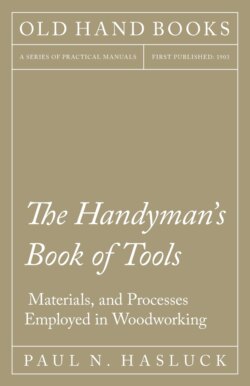Читать книгу The Handyman's Book of Tools, Materials, and Processes Employed in Woodworking - Paul N. Hasluck - Страница 118
На сайте Литреса книга снята с продажи.
AXES AND HATCHETS.
ОглавлениеThese are both percussion and cutting tools, as they combine the offices of the hammer and chisel. The distinction between axes and hatchets is that axes are used with the two hands, and have long handles, and may be swung as sledge hammers. Hatchets are used with one hand; they have short handles, are much lighter and thinner than axes, and are employed more in the trimming than in the felling of timber. Both narrow and broad axes are employed in forestry, the woodman’s choice being affected by the size of the timber and the character of the fibre. A hatchet is handled with the centre of gravity nearer the cutting edge than an axe. A few types of axe heads are here illustrated. Fig. 333 shows the Kent or English pattern, Fig. 334 the Scotch pattern, and Fig. 335 the Suffolk pattern; Fig. 336 shows the Kent or English pattern of felling axe. The handle used with these generally is of the shape shown by Fig. 337. The well-known American wedge-shape axe-head is illustrated by Fig. 338. Of hatchets, Fig. 339 illustrates the Kent or English pattern, and Fig. 340 the Canada or American pattern.
Fig. 332.—American Mallet.
Fig. 333.—Kent Axe Head.
Fig. 334.—Scotch Axe Head.
